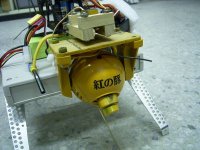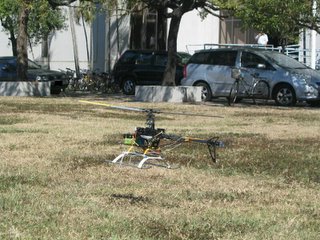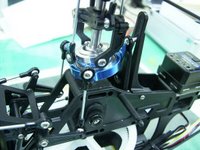After 4 days' efforts, I assemble my first electric RC helicopter. It is not a easy work for me, especially that I have no any experience before.
I follow the instuction manual step by step, and of course do something wrong then correct them. The kit is pretty precise except for the tail boom. The boom has a notch to joint helicopter's body rightly. However, according to its notch, the tail rotor will not be in right angle but somewhat tilt downward. Therefore some modification was done.
In fact, it is not my own helicopter. This small guy is a testbed in
my lab. It will carry some equipment to do some experiments. I and my juniors all expect it can take-off and hover smoothly, then we can carry out our experiments during these 2 days.
Unfortunately, because of my lack of related knowledge about electric helicopter, the
T-rex breaks one of its landing skid.
When I turn on the transmitter and connect the power on T-rex, then push up throttle slightly... Nothing happened... I think the ESC (Electrical Speed Controller) may be the problem. Because I know nothing about brushless motor and the related ESC, I think that I do something wrong with the ESC. After consulting the manual and do some setting, the main rotor start rotating! Good! but something not normal!! I can't control the RPM!!
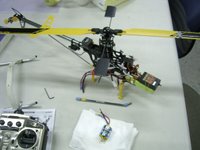
The helicopter rotates its balde faster and faster. In that moment I remember that may be the throttle is reversed, and then push up the throttle stick of the transmitter to the end. However, the RPM seems not reduced. I still have no idea that the ESC has a "slow starting fuction" which makes the RPM increase steady and slowly. In other words, this function confused me when I want to reduce the RPM of main rotor.
Finally, I pull down the throttle to the end, and it is really a disaster. The throttle is reversed, so pull down the throttle means increase the RPM!!
Poor T-rex speed up then roll right quickly. It hits one table and only breaks one of its landing skid. It's really a miracle that no more damage on this helicopter.
This is a astonish but good experience to me. I should not mount the motor on the helicopter before I test its running.
GOOD test steps:- Do NOT mount the motor on helicopter. Test the power system alone
- Turn on the transmitter
- Connect motor, ESC, receiver and battery properly
- Try the throttle response
- Make sure that the motor can handle via the transmitter, especially the "turn-off"
If you have a electric helicopter and you are also a beginner like me, this test "report" may be useful to you. :-)
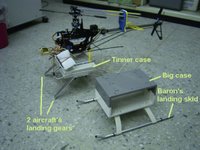 Original design is to put T-rex on an big case, then fix this case on one of my Baron's landing skid. This big case is for equipping experiment's sensors or hardwares. Unfortunately, this arrangement does not work. It suffers extreme vibration! This unwanted vibration does not passed even when T-rex takes off. Therefore, Scott searches for another design.
Original design is to put T-rex on an big case, then fix this case on one of my Baron's landing skid. This big case is for equipping experiment's sensors or hardwares. Unfortunately, this arrangement does not work. It suffers extreme vibration! This unwanted vibration does not passed even when T-rex takes off. Therefore, Scott searches for another design.
